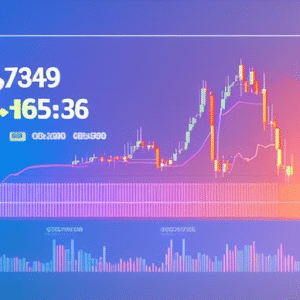Staking Ethereum is an increasingly popular method of passive income generation in cryptocurrency markets. Ethereum staking involves locking up a portion of funds to back the network and earn rewards for validating transactions. Despite the potential benefits, it also comes with several risks that need to be considered before choosing this method of investment. This article will discuss the various risks associated with staking Ethereum, including inflation risk, liquidity risk, security risk, regulatory risk, market risk, risks of delegating funds to validators, risks of choosing the wrong validator, opportunity cost risk and risks of using unstable wallets.
Key Takeaways
- Potential reputational damage from staking Ethereum
- Users should research third-party service providers before staking
- Storing funds in exchanges can result in varying user experiences and fees
- Delegating funds to validators has risks, such as selecting the wrong validator and security risks
Inflation Risk
Staking Ethereum can create an inflation risk due to the increased circulation of ETH tokens as rewards for stakers. This could potentially result in inflationary bubbles, which may lead to economic uncertainty and market instability. Inflation is one of the most significant risks associated with staking ETH, since it can decrease the value of tokens by increasing their supply. As such, careful consideration should be given to ensure that staker rewards are distributed in a way that limits potential negative impacts on the economy.
In addition to inflation risk, there is also a liquidity risk involved with staking ETH. The amount of available liquid capital invested in Ethereum must be carefully monitored to ensure that it does not become too low and cause issues with market liquidity or trading volume. If liquidity levels drop too low, it could limit the ability of users to purchase or trade Ethereum, thereby reducing its value and leading to financial losses for investors and traders alike.
Liquidity Risk
A potential concern of engaging in Ethereum staking is liquidity risk, wherein an investor’s capital may be locked up for extended periods with no option to access funds. This risk arises from the nature of Ethereum staking, whereby users lock their tokens into a smart contract for a fixed period of time, often with predetermined rewards. As such, the user is unable to liquidate their stake during that period, and thus be exposed to considerable liquidity risk.
In order to mitigate this risk, it is critical that investors make sure they are comfortable with the level of security provided by the underlying smart contracts, as well as network reliability. Therefore, it is important for investors to do their own research and ensure that they understand all aspects of how an Ethereum staking process works before committing any funds. With this in mind, transitioning into a secure environment is paramount when looking to minimize liquidity risk associated with Ethereum staking.
Security Risk
Security risk is a major concern for staking Ethereum. It involves the threats of theft, hacking, and phishing that are associated with digital currency. To prevent these risks from resulting in financial losses, users must understand how to properly secure their funds and protect themselves from malicious actors seeking to exploit vulnerabilities within the system. As such, it is important to be aware of common security practices when interacting with the Ethereum network.
Theft
Exposure to theft is a significant risk for holders of Ether when staking, as malicious actors may exploit any vulnerabilities in the system. Privacy leaks and key loss can significantly increase the chances of Ether being stolen. In addition, users must be vigilant about ensuring that their wallets are secure in order to prevent unauthorized access. As such, it is important for all Ether holders to take measures to protect their assets from potential theft. To do so they should ensure that they keep up-to-date with best practices on wallet security, including setting strong passwords and two-factor authentication protocols wherever possible. Moving forward, it will be essential for Ether holders to remain aware of the risks posed by hackers seeking to exploit any weaknesses in their security setup.
Hacking
Hacking is an ever-present threat to Ether holders, with hackers continually finding new ways to exploit vulnerabilities in digital systems. According to a recent study, approximately 10% of all cryptocurrency transactions involve some degree of hacking or fraud. In particular, the risks posed by malicious actors are becoming more and more prevalent; these include data breaches, stolen funds due to weak private keys, and the installation of malware on user devices. Furthermore, any system that stores Ether can be vulnerable if basic security protocols such as antivirus software or strong passwords are not implemented correctly.
The risk of phishing attacks is also particularly high for Ether users due to its popularity. Phishing attacks are often conducted via emails or other online communication mediums that contain malicious links which can lead users to fraudulent websites or download malicious software onto their device. As such, it is important for users to be aware of these threats when interacting with unknown sources online in order to protect their Ether holdings from potential losses caused by hackers. To this end, it is essential that users always verify the legitimacy of websites they interact with and never click on suspicious links sent via email or messaging services
Phishing
Phishing attacks pose a significant threat to Ether holders by attempting to deceive users into providing personal information or clicking on malicious links. Social engineering techniques are commonly used in phishing scams, including the use of emails and texts that appear to be from a legitimate source but contain malicious links. These link often lead to fake websites that appear authentic, collecting personal information such as passwords or credit card numbers for identity theft. By following these malicious links, users may also unwittingly download malicious software onto their computers that enables hackers access to their systems. Furthermore, even after the data is collected by attackers it can still be difficult for victims to recover stolen funds if they have already been sent off-chain. As such, phishing schemes remain an ever-present risk for stakers of Ethereum and other digital assets; however, there are measures which can be taken in order to mitigate these risks. Transitioning into the next section about regulatory risk, there is increasing pressure on governments around the world to introduce regulations which govern how cryptocurrencies should operate and protect users from fraudulent activities.
Regulatory Risk
The potential for regulatory interference poses a risk to Ethereum stakers, as evidenced by recent studies indicating that the threat of government action has resulted in reduced crypto trading volumes. For example, in 2019, the US Securities and Exchange Commission imposed financial penalties on two exchanges for failing to register as a national securities exchange. This demonstrates that regulators have the power to impose compliance costs on activities related to Ethereum staking. Such compliance costs can be quite significant, resulting in reduced profitability and increased operational complexity for those involved with Ethereum staking. In addition, further changes in regulations could potentially impose additional restrictions or prohibitions on certain types of activity related to Ethereum staking. As such, it is important for those engaged in Ethereum staking activities to remain aware of any changes in relevant regulations so they can adjust their operations accordingly. Consequently, this uncertainty surrounding potential regulatory actions serves as a risk factor when considering participation in Ethereum staking activities. To mitigate this risk, participants should ensure they are familiar with applicable regulations and consult with legal counsel before engaging in any such activities. With these measures taken into consideration, market risks associated with Ethereum staking can be mitigated.
Market Risk
While regulatory risk is an important factor to consider when staking Ethereum, another significant consideration is market risk. Market risk can be seen as the potential for a decrease in the value of Ether resulting from price volatility or changes in reward structure. To illustrate this concept, a table comparing price and reward volatility of staked Ether versus non-staked Ether is presented in Table 1 below. Price volatility is measured by analyzing the percentage change of the asset’s price over time while reward volatility measures how much return on investment (ROI) fluctuates over time.
| Staked | Non-Staked |
|---|---|
| High Price Volatility | Low Price Volatility |
| High Reward Volatility | Low Reward Volatility |
Table 1: Comparison of Price and Reward Volatilities between Staked and Non-Staked Ethereum.
As can be seen from Table 1, staking Ethereum entails significantly higher levels of both price and reward volatility compared to not staking it. This means that investors should take into account these risks before deciding whether or not to stake their Ether. In order to mitigate these risks, careful analysis must be undertaken prior to making any decision about investing in Ethereum or other cryptocurrencies through staking. Moving onto technical risk, which is another important factor that must be considered when investing in Ethereum via staking…
Technical Risk
Technical risk refers to the potential for network congestion and smart contract bugs to affect staking on Ethereum. Such risks are caused by the decentralized nature of blockchain technology, which could potentially lead to unforeseen events with serious consequences. As such, it is important that stakers understand the technical aspects of a project before they decide to stake their ETH in order to minimize any potential risks.
Network Congestion
Unavoidably, network congestion can be an issue for staking Ethereum. With the rise of decentralized applications (dApps) running on the Ethereum blockchain, the network has become increasingly congested due to an increased demand for transactions and scaling issues. This has caused transaction costs to soar and stakers may have difficulty completing their transactions in a timely manner as they compete with other users for block space and gas resources. As such, this could lead to potential losses if a transaction is not completed on time or is too expensive for a user’s budget. Additionally, it could also make it difficult for large-scale staking operations to function properly if there are continuous delays in executing transactions. Therefore, it is important that users evaluate whether their staking pool will be able to handle any potential congestion when deciding which platform to use.
Smart Contract Bugs
Due to the complexity of Ethereum smart contracts, there is a risk of bugs that could put users’ funds at risk. According to research conducted by Chainalysis, over $1 billion USD has been lost due to smart contract bugs since 2017. As such, it is essential for users to understand the potential risks associated with using these contracts, as costly errors and deceptive practices can occur during their execution. The lack of proper oversight on Ethereum also makes it difficult for users to detect and report any suspicious activity. To mitigate this risk, users should ensure they have a clear understanding of the code before engaging in any staking activities on Ethereum. Furthermore, user should conduct thorough research into the project prior to investing in order to gain an understanding of its security measures and protocols. By doing so, they can help protect themselves from potential losses due to smart contract bugs. Consequently, counterparty risk must also be taken into account when staking on Ethereum.
Counterparty Risk
Staking Ethereum carries with it a considerable risk of counterparty default, which can potentially result in devastating losses. When staking Ethereum, users must be aware that they are placing counterparty trust in the service provider or custodian for their funds. This means that if these entities fail to meet their financial obligations, then there is a risk of substantial losses as a result. As such, it is important to assess the financial stability and reputation of any potential service providers before trusting them with funds. In addition, users should regularly monitor the performance of their custodians to ensure that they remain financially sound and capable of meeting their obligations. With this in mind, transitioning into the next section about ‘risks of locking funds’ becomes an obvious decision for those considering staking Ethereum.
Risks of Locking Funds
When investing in Ethereum, one must be cognizant of the potential risks associated with locking funds for an extended period of time. The primary risk is that once funds are locked in a smart contract, they may be difficult to retrieve due to the inherent code enforcement of smart contracts and their immutability. Additionally, there is the risk of token vesting which can cause investors to miss out on potential profits as tokens cannot be sold or traded until a pre-set date or condition has been met. Furthermore, if investors are not careful about how they structure their staking agreement, they may find themselves locked into a deal which could potentially result in significant losses down the line.
The table below outlines some key considerations when evaluating whether or not to stake Ethereum:
| Consideration | Description |
|---|---|
| Length of Term | How long will it take before an investor can liquidate their holdings? |
| Penalty Structure | What penalties apply if an investor chooses to terminate early? Are there any other fees associated with staking? |
| Liquidity Risk | Is there enough liquidity available in order to sell/trade tokens without suffering large losses? |
From these risks associated with locking funds for extended periods of time, we now turn our attention to understanding the tax implications that come with staking Ethereum.
Tax Risk
Investors must take into account the tax implications associated with staking Ethereum before committing to a contract. Staking presents an inherent risk when it comes to taxation, as investors are responsible for understanding and maintaining proper tax compliance records. This includes not only filing the taxes on time but also keeping track of all applicable deductions and credits that may apply to staking earnings. Furthermore, there is an additional burden of proof in terms of financial auditing if any irregularities arise. As such, investors must be aware of their local tax laws, potential audit requirements, and any other related regulations that could affect their staking earnings:
- Ensure they understand the relevant local tax laws
- Possess documentation detailing income and expenditure related to staking
- Monitor for changes in legislation regarding taxation of crypto-assets
- Be prepared for a financial audit should irregularities occur
If managed properly, these risks can be mitigated by taking advantage of available resources such as professional tax advisors who specialize in cryptocurrency investments. With this knowledge in hand, investors can move forward confidently towards the subsequent section about ‘reputation risk’.
Reputation Risk
Moving from the topic of taxation risk, another important risk to consider when staking Ethereum is reputation risk. Reputation damage and trust erosion are two key risks associated with staking [Ethereum]. If a user’s stake is stolen or mismanaged, it may lead to reputational damage for the user as well as their trusted counterparties. This could cause a loss of trust in the digital asset industry, which could have serious consequences on market liquidity and investor confidence. As such, users must be aware of potential reputational damage that could arise from staking [Ethereum], and take appropriate precautions to protect themselves against such risks. With this in mind, it is critical that users thoroughly research any third-party service providers they choose to work with before engaging in any form of staking activity. By doing so, users can minimize the potential for reputation damage or trust erosion caused by poor management of their stake.
Having discussed both taxation and reputation risks associated with staking Ethereum, we now turn our attention to another important topic: the risks associated with storing funds in exchanges.
Risks of Storing Funds in Exchanges
Storing digital assets in exchanges may lead to a variety of risks which must be considered before investing. One such risk is that user experience can vary widely from one exchange to another, and even within the same exchange depending on factors such as liquidity. Additionally, exchange fees can also be an issue for investors looking to store larger sums of Ethereum, as some exchanges charge a fee when depositing or withdrawing funds – these fees can add up over time and take away from the investor’s profit margin. This should be taken into account when deciding where to store funds, as many wallets do not charge any fees for transactions. Transitioning into delegating funds to validators brings forth its own set of risks which must be carefully weighed against potential returns.
Risks of Delegating Funds to Validators
When considering delegation of digital assets to validators, investors must be aware of a range of potential consequences that could arise from such an action. These include:
- The risk associated with selecting the wrong validator;
- Security risks associated with delegating funds to validators;
- The chance of losing out on rewards due to network latency; and
- Inaccurate calculations of gas fees for transactions related to staking activities.
It is critical for users to carefully consider their options when selecting a validator, as the wrong choice can have serious repercussions on their returns from staking or even result in loss of capital. Delegators must also ensure they understand all security risks associated with delegating funds, and take appropriate steps to mitigate these risks, such as using hardware wallets or other secure storage solutions. Additionally, delays caused by network latency can affect the timely collection of rewards and other staking benefits, while inaccurate calculation of gas fees may lead to unexpected charges or losses in case of failed transactions.
Risks of Choosing the Wrong Validator
When delegating funds to validators in staking Ethereum, it is important to consider the risks of choosing the wrong validator. Validator selection can have a major impact on the rewards received for staking Ethereum. For instance, if an individual chooses a validator that does not perform optimally, they may miss out on potential staking rewards from other more successful validators. Additionally, selecting a validator that charges high fees or has unreliable uptime can further reduce overall returns from staking Ethereum. As such, it is crucial for individuals to research available options in order to ensure they select a reliable and cost-effective option when delegating their funds to a validator.
The risks associated with selecting the wrong validator are compounded by opportunity costs; if an individual chooses an inefficient or overpriced option then they will be sacrificing any potential gains they could have made with another provider. Therefore, it is essential for individuals to conduct thorough due diligence before committing funds to any particular validator in order to maximize their chances of earning optimal returns from their staking activities. By taking this approach, individuals can minimize their risk profile and enjoy more peace of mind as they reap the benefits of staking Ethereum. Moving forward, it is important consider the next risk factor – opportunity cost risk – when engaging in Ethereum staking activities.
Opportunity Cost Risk
Opportunity cost risk is the potential loss of earning higher returns from alternative staking activities if an incorrect validator is selected. It is important to consider this risk when choosing a validator by performing a cost benefit analysis to decide which option will be more profitable in the long run, taking into account transaction fees and other costs associated with each option. Potential risks of opportunity cost include:
- Loss of potential rewards due to lower returns on staked funds
- Higher transaction fees for an incorrect validator selection
- Lost time if needing to switch validators after selecting the wrong one
Considering these risks can help users make informed decisions about their staking activities and avoid costly mistakes. To mitigate these risks, it is important to perform thorough research on all options before settling on a specific validator. With this knowledge, users can make better decisions that maximize their profits while minimizing losses due to opportunity cost. As such, transitioning into the subsequent section about ‘risks of using unstable wallets’ should be viewed as an important step towards understanding how best to protect one’s investments in Ethereum staking endeavors.
Risks of Using Unstable Wallets
Having discussed the opportunity cost risk associated with staking Ethereum, another major risk factor to consider is the risks of using unstable wallets. Wallet selection plays a major role in staking rewards and can be a determining factor in how successful one’s investment will be. Unstable wallets can often lead to lost funds or lack of security which makes them an undesirable option for staking Ethereum.
| Advantages | Disadvantages |
|---|---|
| Secure | High Fees |
| Easy Accessibility | Lack of Transparency |
| Comprehensive Support | Prone to Hacking/Theft |
| Variety of Options Available | Limited Features Depending on Service Provider/Wallet Type |
In order to avoid potential mishaps, it is important for investors to research and select a wallet that meets their needs and provides enough security while also being user-friendly. Each wallet has its own advantages and disadvantages, so understanding these differences can help individuals make an informed decision about which type of wallet best suits their individual needs when it comes to staking Ethereum. By taking into account all factors related to the selection process, investors can maximize their chances of success while minimizing the risks involved with using unstable wallets.







